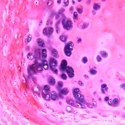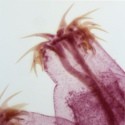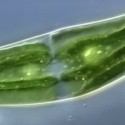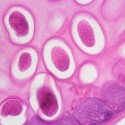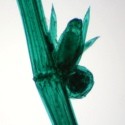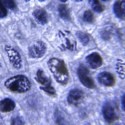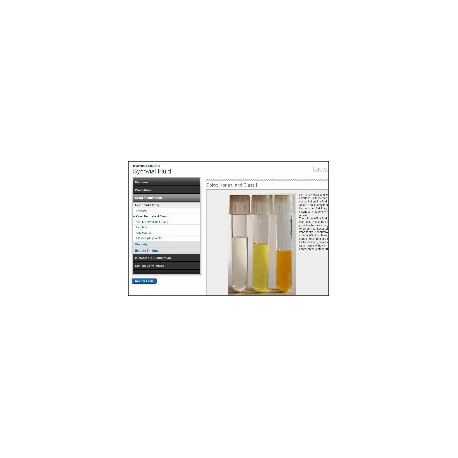No products
Prices are tax excluded
Body Fluids Tutor
WU-5
The Body Fluid Tutor includes: Synovial Fluid Module, Serous Fluid Module, Seminal Fluid Module, Cerebrospinal Fluid Module, Amniotic Fluid Module.
Available in 12 to 24 hours
By buying this product you can collect up to 53 loyalty points. Your cart will total 53 points that can be converted into a voucher of $7.95.
Volume discounts
| Quantity | Discount | You Save |
|---|---|---|
| 2 | 3% | Up to $32.35 |
| 3 | 5% | Up to $80.87 |
Synovial Fluid Module
Classification of synovial effusions. Gross and microscopic examination,
including the use of polarized light
COURSE OUTLINE:
Overview: Learning Objectives, Anatomy, Specimen Collection, SF Classification.
Procedures: Polarized Light, Stains.
Gross Examination: Colour and Clarity, Viscosity, Notable Finding.
Microscopic Examination: Cells , Crystals, Micro-organisms, Lipids, Artefacts.
Clinical Correlations: Gout, Pseudogout.
LEARNING OBJECTIVES- Describe the basic classification of synovial effusions
- Describe the gross appearance of synovial fluid specimens
- Discuss the principles and applications of polarizing microscopy and compensated polarizing microscopy, and how to perform them
- Distinguish urate crystals from calcium pyrophosphate dihydrate (CPPD) crystals
- Describe other crystals, artefacts, inclusions, and cell types that may be present in synovial fluids
Serous Fluid ModuleSerous fluid production. Distinguishing transudates and exudates using laboratory testing.
Gross and microscopic examination of serous fluids
COURSE OUTLINE:
Overview: Learning Objectives, Anatomy, Normal Production, Transudate, Exudate, Laboratory Findings, Clinical Causes.
Gross Examination: Transudate, Turbid, Haemorrhagic, Clot, Bile Stained, Chylous.
Procedures: Cell Count, Cyto-centrifuge, Wright Stain, Gram Stain.
Microscopic Exam: Cell Types, Normal, Inflammation, Haemorrhage, Infection, Malignancy.
Exams: Exam 1, Exam 2.
LEARNING OBJECTIVES- Describe the normal production of serous fluids and the mechanisms of formation of transudates and exudates
- Distinguish transudates and exudates using lab testing, and understand their significance
- Describe the gross appearance of serous fluid specimens
- Describe the principles of manual chamber counts, cytocentrifuge preparation, and Wright staining
- Identify the major types of normal and abnormal cells in serous fluids and their significance
Seminal Fluid ModuleSemen analysis, including the determination of sperm concentration,
motility and morphology
COURSE OUTLINE:
Overview: Learning Objectives, Anatomy, Specimen Collection Quality Control, References.
Gross Examination: Fluid Characteristics, pH.
Procedures: Prepare Wet Mount, Load Hemacytometer, Prepare Semen Smear, Staining.
Microscopic Examination: Components of Fluid, Sperm Motility, Other Wet Mount Observations, Sperm Concentration, Sperm Morphology, Other Cell Types, Differential Count.
Clinical Correlations: Semen Analysis, Sperm Function, Sperm Vitality, Anti-Sperm Antibodies, Post-vasectomy Evaluation, Prostatitis, CAVD, Ejaculatory Dysfunction.
LEARNING OBJECTIVES- List the glandular contributions and cellular components of seminal fluid
- Describe the methods used to determine sperm concentration, motility and morphology
- List the abnormalities detected and reference ranges for semen analysis
- Discuss the goals and limitations of semen analysis in the clinical setting
Cerebrospinal Fluid ModuleOverview of the lumbar puncture procedure. Gross and microscopic
examination of cerebrospinal fluid
COURSE OUTLINE:
Overview: Learning Objectives, Anatomy, Specimen Collection, Laboratory Findings, Microbiology.
Gross Examination: Overview, Clarity, Traumatic Tap.
Procedures Cell Count, Cyto-centrifuge, Wright Stain, Gram Stain, Electrophoresis, Latex Agglutination.
Microscopic Examination: Cell Types, Normal, Inflammation, Haemorrhage, Infection, Malignancy.
Exams: Exam 1, Exam 2.
LEARNING OBJECTIVES- Describe the production and collection of cerebrospinal fluid (CSF)
- Describe the gross appearance of CSF specimens
- Describe the principles of manual chamber counts, cytocentrifuge preparation, and Wright staining
- Identify the major types of normal and abnormal cells in CSF and describe their significance
Amniotic Fluid ModuleThe amniocentesis procedure and laboratory analysis of amniotic fluid
COURSE OUTLINE:
Overview: Learning Objectives Specimen Collection.
Gross Examination: Normal Fluid, Abnormal Fluids.
Clinical Correlations: Screening for Birth Defects, Genetic Testing, Open Neural Tube Defects, Foetal Maturity, Haemolytic Disease.
LEARNING OBJECTIVES- Describe the amniocentesis procedure and the most common indications for amniocentesis
- List the most common genetic abnormalities detected by cytogenetic analysis and their clinical features
- Describe the L/S ratio and other assays used to assess foetal lung maturity
- Describe the tests used to screen for open neural tube defects
- Describe haemolytic disease of the newborn (HDN) and how the severity of HDN is assessed in the lab
This product is now supplied as an online course. You have unlimited access to the course for 5 years.

